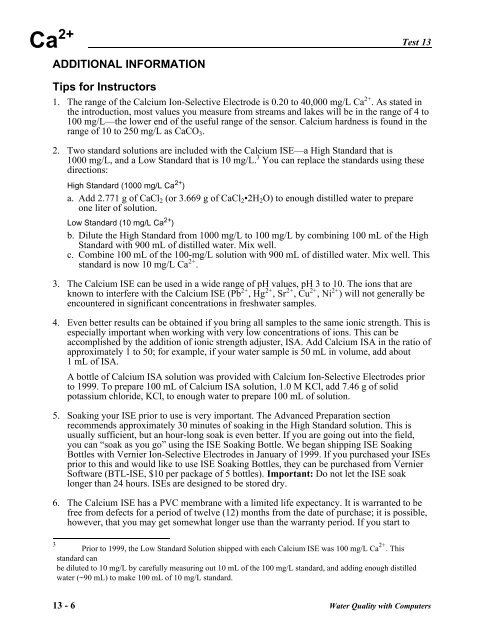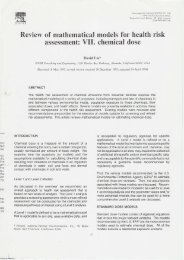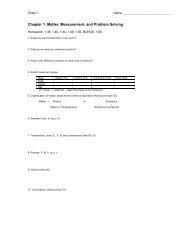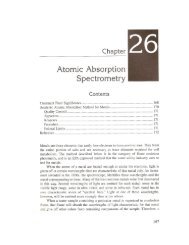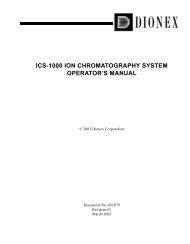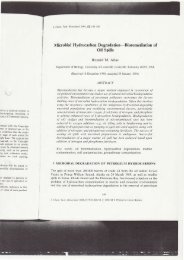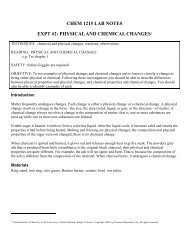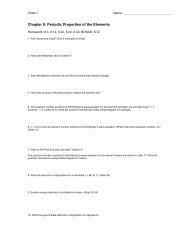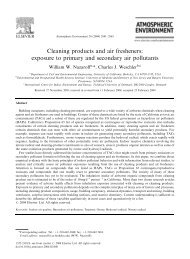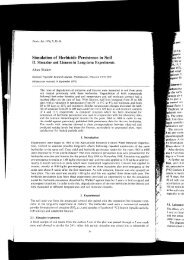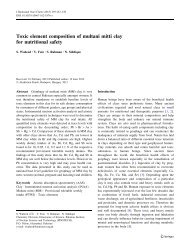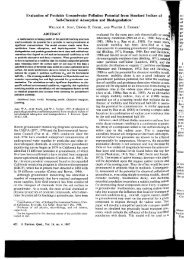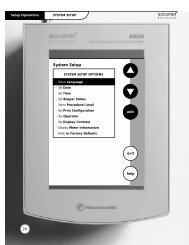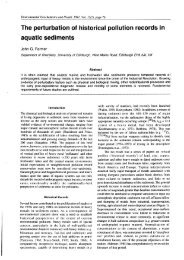Calcium and Water Hardness
Calcium and Water Hardness
Calcium and Water Hardness
You also want an ePaper? Increase the reach of your titles
YUMPU automatically turns print PDFs into web optimized ePapers that Google loves.
Ca 2+<br />
ADDITIONAL INFORMATION<br />
Test 13<br />
Tips for Instructors<br />
1. The range of the <strong>Calcium</strong> Ion-Selective Electrode is 0.20 to 40,000 mg/L Ca 2+ . As stated in<br />
the introduction, most values you measure from streams <strong>and</strong> lakes will be in the range of 4 to<br />
100 mg/LÑthe lower end of the useful range of the sensor. <strong>Calcium</strong> hardness is found in the<br />
range of 10 to 250 mg/L as CaCO 3 .<br />
2. Two st<strong>and</strong>ard solutions are included with the <strong>Calcium</strong> ISEÑa High St<strong>and</strong>ard that is<br />
1000Êmg/L, <strong>and</strong> a Low St<strong>and</strong>ard that is 10 mg/L. 3 You can replace the st<strong>and</strong>ards using these<br />
directions:<br />
High St<strong>and</strong>ard (1000 mg/L Ca 2+ )<br />
a. Add 2.771 g of CaCl 2 (or 3.669 g of CaCl 2 ¥2H 2 O) to enough distilled water to prepare<br />
oneÊliter of solution.<br />
Low St<strong>and</strong>ard (10 mg/L Ca 2+ )<br />
b. Dilute the High St<strong>and</strong>ard from 1000 mg/L to 100 mg/L by combining 100 mL of the High<br />
St<strong>and</strong>ard with 900 mL of distilled water. Mix well.<br />
c. Combine 100 mL of the 100-mg/L solution with 900 mL of distilled water. Mix well. This<br />
st<strong>and</strong>ard is now 10 mg/L Ca 2+ .<br />
3. The <strong>Calcium</strong> ISE can be used in a wide range of pH values, pH 3 to 10. The ions that are<br />
known to interfere with the <strong>Calcium</strong> ISE (Pb 2+ , Hg 2+ , Sr 2+ , Cu 2+ , Ni 2+ ) will not generally be<br />
encountered in significant concentrations in freshwater samples.<br />
4. Even better results can be obtained if you bring all samples to the same ionic strength. This is<br />
especially important when working with very low concentrations of ions. This can be<br />
accomplished by the addition of ionic strength adjuster, ISA. Add <strong>Calcium</strong> ISA in the ratio of<br />
approximately 1 to 50; for example, if your water sample is 50 mL in volume, add about<br />
1ÊmL of ISA.<br />
A bottle of <strong>Calcium</strong> ISA solution was provided with <strong>Calcium</strong> Ion-Selective Electrodes prior<br />
to 1999. To prepare 100 mL of <strong>Calcium</strong> ISA solution, 1.0 M KCl, add 7.46 g of solid<br />
potassium chloride, KCl, to enough water to prepare 100 mL of solution.<br />
5. Soaking your ISE prior to use is very important. The Advanced Preparation section<br />
recommends approximately 30 minutes of soaking in the High St<strong>and</strong>ard solution. This is<br />
usually sufficient, but an hour-long soak is even better. If you are going out into the field,<br />
you can Òsoak as you goÓ using the ISE Soaking Bottle. We began shipping ISE Soaking<br />
Bottles with Vernier Ion-Selective Electrodes in January of 1999. If you purchased your ISEs<br />
prior to this <strong>and</strong> would like to use ISE Soaking Bottles, they can be purchased from Vernier<br />
Software (BTL-ISE, $10 per package of 5 bottles). Important: Do not let the ISE soak<br />
longer than 24 hours. ISEs are designed to be stored dry.<br />
6. The <strong>Calcium</strong> ISE has a PVC membrane with a limited life expectancy. It is warranted to be<br />
free from defects for a period of twelve (12) months from the date of purchase; it is possible,<br />
however, that you may get somewhat longer use than the warranty period. If you start to<br />
3<br />
Prior to 1999, the Low St<strong>and</strong>ard Solution shipped with each <strong>Calcium</strong> ISE was 100 mg/L Ca 2+ . This<br />
st<strong>and</strong>ard can<br />
be diluted to 10 mg/L by carefully measuring out 10 mL of the 100 mg/L st<strong>and</strong>ard, <strong>and</strong> adding enough distilled<br />
water (~90 mL) to make 100 mL of 10 mg/L st<strong>and</strong>ard.<br />
13 - 6 <strong>Water</strong> Quality with Computers


